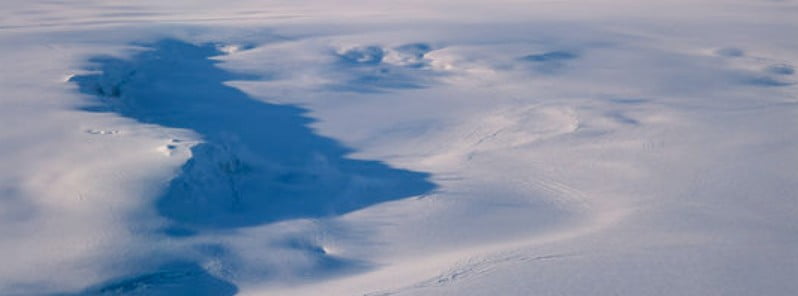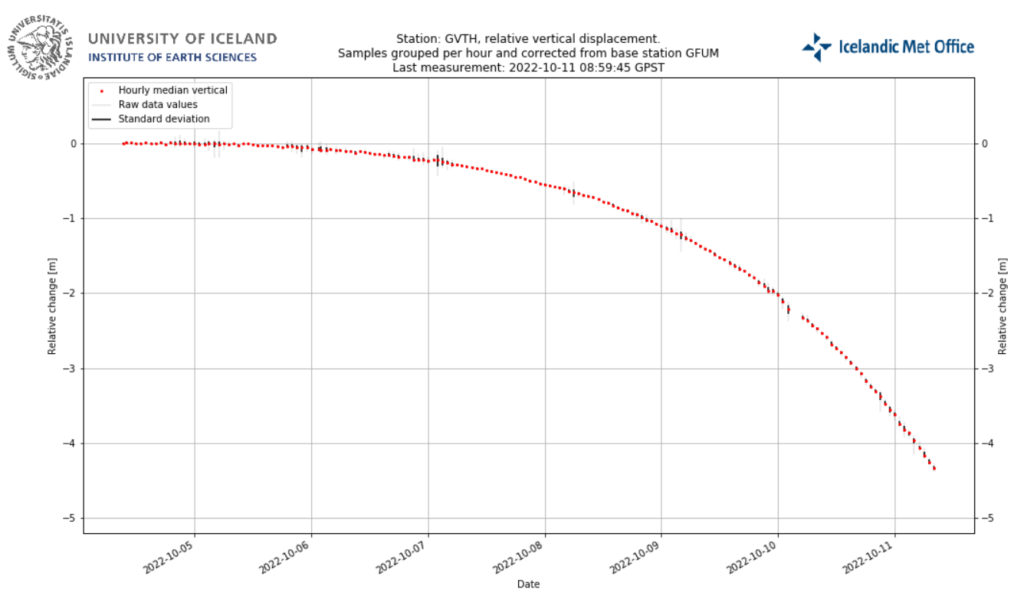Glacial flood in Grímsvötn, Aviation Color Code raised to Yellow, Iceland

A new glacial flood started at Grímsvötn, a subglacial volcano under Vatnajökull, Iceland, on October 10, 2022, prompting authorities to raise the Aviation Color Code to Yellow and announce the State of Uncertainty.
- Glacial flooding can trigger subglacial eruptions, which have been known to happen at Grímsvötn.
- This is the most active volcano in Iceland with eruption intervals every 5 to 10 years. The last took place in 2011 and was quite large and powerful.
The ice sheet has receded by almost 3 m (10 feet) several days before the flood started and by 7 m (23 feet) on October 12, the Icelandic Met Office (IMO) reports.1 If the Grímsvötn subglacial lake drains completely, the ice shelf can likely sink by some 10 – 15 m (33 – 50 feet) in total.
The flow is currently at 300 m3/s so IMO predicts that the maximum flow out of the lakes will be late Thursday, October 13 or Friday.

It can be calculated that it takes about 24 hours for runoff water to flow under the Skeiðarjökull glacier from Grímsvötn and down to the course of the Gígjukvíslar by Highway 1. Going forward, it is calculated that the maximum flow out of the lakes will be around 500 m3/s.
It is likely that the flow at the bridge over Gígjukvísl will be less than out of the lakes themselves due to the attenuation of the runoff in the reservoirs in front of Skeiðarjökull. The flow at the bridge in this run will therefore be equal to the high summer flow and will not have any effect on structures such as roads and bridges.
There is little or no seismic activity in the volcano and no volcanic eruptions have been detected.
The last flood from Grímsvötn was in December last year, so it’s been a short time since the last flood.
There are examples of volcanic eruptions in Grímsvötn coinciding with glacial floods. It is likely that the sudden pressure relief due to decreasing water level can trigger eruptions. The last time such a scenario happened was in 2004, and before that in 1934 and 1922.
However, Grímsvötn has much more often had floods without an eruption.
Two things need to happen for an eruption to start: pressure relief has to be enough to “trigger” and wake up the volcano, and magma pressure within the volcano has to be enough to set off an eruption, but there is uncertainty about both aspects.
The chance of an eruption will quickly decrease after the flood.
The last eruption at this volcano occurred in 2011 CE – May 21 to 28, 2011 (VEI 4) – and emitted about 0.8 km3 (0.20 mi3) of basaltic tephra (bulk volume).
This volcano has a history of major eruptions up to VEI 6.
Geological summary
Grímsvötn, Iceland’s most frequently active volcano in historical time, lies largely beneath the vast Vatnajökull icecap. The caldera lake is covered by a 200 m (650 feet) ice shelf, and only the southern rim of the 6 x 8 km (3.7 x 5 miles) caldera is exposed.
The geothermal area in the caldera causes frequent jökulhlaups (glacier outburst floods) when melting raises the water level high enough to lift its ice dam.
Long NE-SW-trending fissure systems extend from the central volcano. The most prominent of these is the noted Laki (Skaftar) fissure, which extends to the SW and produced the world’s largest known historical lava flow during an eruption in 1783.
The 15 km3 (3.6 mi3) basaltic Laki lavas erupted over a 7-month period from a 27 km (16.7 miles) long fissure system. Extensive crop damage and livestock losses caused a severe famine that resulted in the loss of one-fifth of the population of Iceland.2
References:
1 Minor jökulhlaup in Grímsvötn – October 10 and 12, 2022 – IMO
2 Grímsvötn – Geological summary – GVP
Featured image credit: IMO

Commenting rules and guidelines
We value the thoughts and opinions of our readers and welcome healthy discussions on our website. In order to maintain a respectful and positive community, we ask that all commenters follow these rules.